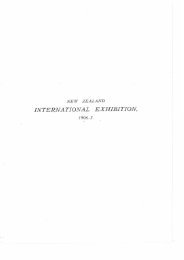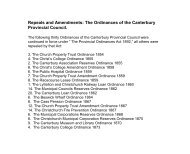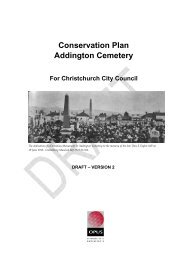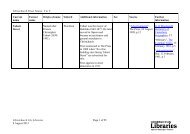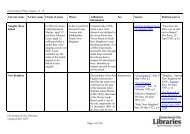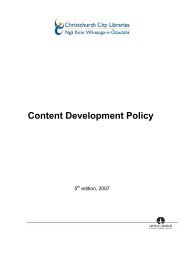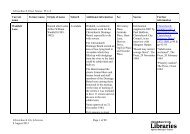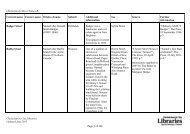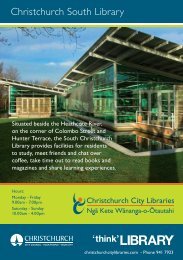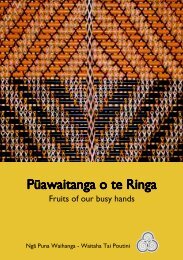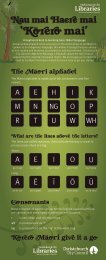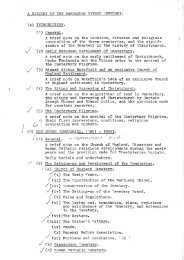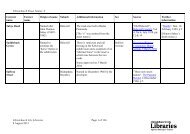Linwood Cemetery Tour Guide - Christchurch City Libraries
Linwood Cemetery Tour Guide - Christchurch City Libraries
Linwood Cemetery Tour Guide - Christchurch City Libraries
You also want an ePaper? Increase the reach of your titles
YUMPU automatically turns print PDFs into web optimized ePapers that Google loves.
Reg died during an epileptic fit in 1914, according to the family story just prior to<br />
what would have been his wedding day.<br />
Area 9<br />
Row A<br />
No. 4790<br />
Townend<br />
Harriet Towenend, 38, died on 12 February 1893. Her husband, Joseph Henry, 55,<br />
died on 11 July 1902.<br />
Joseph Henry Townend was a doctor in Victorian <strong>Christchurch</strong>. He and his wife had<br />
several children, one of the daughters, Nina, marrying James Grant Ogilvie-Grant,<br />
Earl of Seafield. The earl’s father, an obscure Oamaru resident, had succeeded to the<br />
Scottish title on the death of his father who had himself unexpectedly succeeded to the<br />
title late in life. The Oamaru earl had not long survived his elevation to the ranks of<br />
the nobility. Nina and James were to settle in Scotland but James was killed in World<br />
War I.<br />
Townend ‘began with one shilling and sixpence for medicine and advice but later<br />
charged pretty high fees’. In the early 1890s famed architect Samuel Hurst Seager<br />
designed for Dr. Townend a thirty room private hospital, ‘Strathmore’, in Ferry Road.<br />
‘Strathmore’ was used mainly for surgical cases, accommodated 40 patients and was a<br />
pioneer in aseptic surgery, having a glass-lined operating theatre. It remained a private<br />
hospital until 1918 when it became the Girls’ Receiving Home which was run by the<br />
Education Department. The home was closed about 1980 and demolished in the late<br />
1990s.<br />
In 1900 Joseph Townend entered into the secret marriage which became the best-<br />
known union in <strong>Christchurch</strong> history. He married Annie Quayle, middle-aged spinster<br />
daughter of Glenmark sheep-king and domestic tyrant George Henry ‘Scabby’ Moore<br />
who was now old and blind. The groom died in 1902, the unsuspecting father-in-law<br />
in 1905. In widowhood the second Mrs. Townend bought a Fendalton property,<br />
‘Karewa’, which she gave the name by which it is now known, ‘Mona Vale’. Annie<br />
Quayle Townend died in 1914.<br />
Row B<br />
No. 4798/9<br />
Bowker<br />
Born at Buckworth Lodge, near the village of Buckwoth, Huntingdonshire, on 10<br />
December 1840, Henry Layton Bowker was of ‘old yeoman stock’. He ‘came of a<br />
family which had been settled in the Midlands for many generations, both his paternal<br />
and maternal grandfathers being deputy-lieutenants for their county’.<br />
In 1863 Henry emigrated to Canterbury ‘with 100 pounds in his pocket’ and<br />
accompanied by a younger brother, Charles. They bought a pair of horses and a van,<br />
stocked it with goods suitable for the country ‘and journeyed from farm to farm across<br />
the then almost roadless plains and bridgeless rivers, often spending the night under<br />
the van’. Subsequently they settled down to storekeeping. Henry ‘turned his hand to<br />
<strong>Linwood</strong> <strong>Cemetery</strong> <strong>Tour</strong> <strong>Guide</strong><br />
Updated 2013<br />
29



